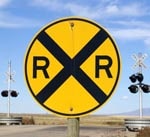
The next phase of FRA’s efforts to improve safety at grade crossings will aim to employ smarter uses of technology, increase public awareness of grade crossing safety, including distracted driving, improve signage, work closer in partnership with states and local safety agencies, and call for new funding for greater safety at grade crossings.
“Recent accidents in New York and California are important reminders of our shared challenge to both educate the public about grade crossing safety, and to enforce appropriate behavior around railroad operations,” said U.S. Transportation Secretary Anthony Foxx. “Grade crossing and trespassing accidents are serious challenges to maintaining public safety. Every three hours of every day, someone is hit by a train in the United States and we must do all we can to heighten public awareness, strengthen enforcement efforts and pioneer new technologies to better secure public safety.”
There are 250,711 grade crossings in the United States; about 51 percent of those are public-at-grade crossings. Only half of all public grade crossings have automatic-warning systems and only a third have flashing lights and gates. Approximately 15 percent of all grade crossings are grade separated – the safest of all crossings – meaning railroad traffic is completely separated from vehicle and pedestrian traffic.
States and localities have traditionally played the most significant role in determining the type of warning system present at grade crossings, with most system decisions determined by traffic levels. Upgrades to existing grade crossings are also the responsibility of states and local communities. Under federal law and regulations, railroads are responsible for inspecting, testing, and maintaining highway-rail grade crossings. The FRA issues and enforces regulations on crossing safety, issues guidance on best practices and conducts research on ways to improve crossings safety.
Additionally, the federal government provides more than $287.9 million annually to states to help improve and enhance safety at public grade crossings.
“The reality is that while the overall number of deaths and injuries from grade crossing incidents has come down significantly over the last two decades, this remains a serious problem. We can and should be doing everything we possibly can to keep drivers, pedestrians, and train crews and passengers safe at grade crossings,” said Sarah Feinberg, Acting Administrator at the Federal Railroad Administration. “In addition to this renewed outreach to law enforcement, FRA will take a fresh look at our grade crossing programs and activities.”
Facts on grade crossings:
- 239 people were killed and 763 people were injured in grade crossing incidents in 2014.
- In Fiscal Year 2014 the top ten states with the most grade crossing accidents in ranking order include: Texas; California; Illinois; Indiana; Georgia; Alabama; Louisiana; Ohio; Florida; Tennessee.
- The FRA, in partnership with the Federal Highway Administration and State Departments of Transportation have worked together with railroads to close more than 18,000 grade crossings nationwide since 2008.
To learn more about the problem at grade crossings or to view our Highway-Rail Grade Crossing Resource Guide for reporters, visit our press room at http://www.fra.dot.gov/Page/P0095.
Related News
- New Jersey Train Length, Crew Size Law Awaits Governor’s Signature
- CSX Conductor, Single Mother Devastated in Head-on Collision
- Union Mourns the Loss of Brother Charles Harrison
- FRA Issues Grade-Crossing Safety Advisory
- Amtrak To Give SMART-TD Members Holiday Bonuses
- Value of Unions
- 2026 Railroad Retirement and Unemployment Insurance Tax Changes
- SMART-TD Members on UP Properties Ratify Five-Year Agreement
- Railroader’s Son to Perform at Carnegie Hall
- Rail Trespassing and Suicide Fatalities Up 70%